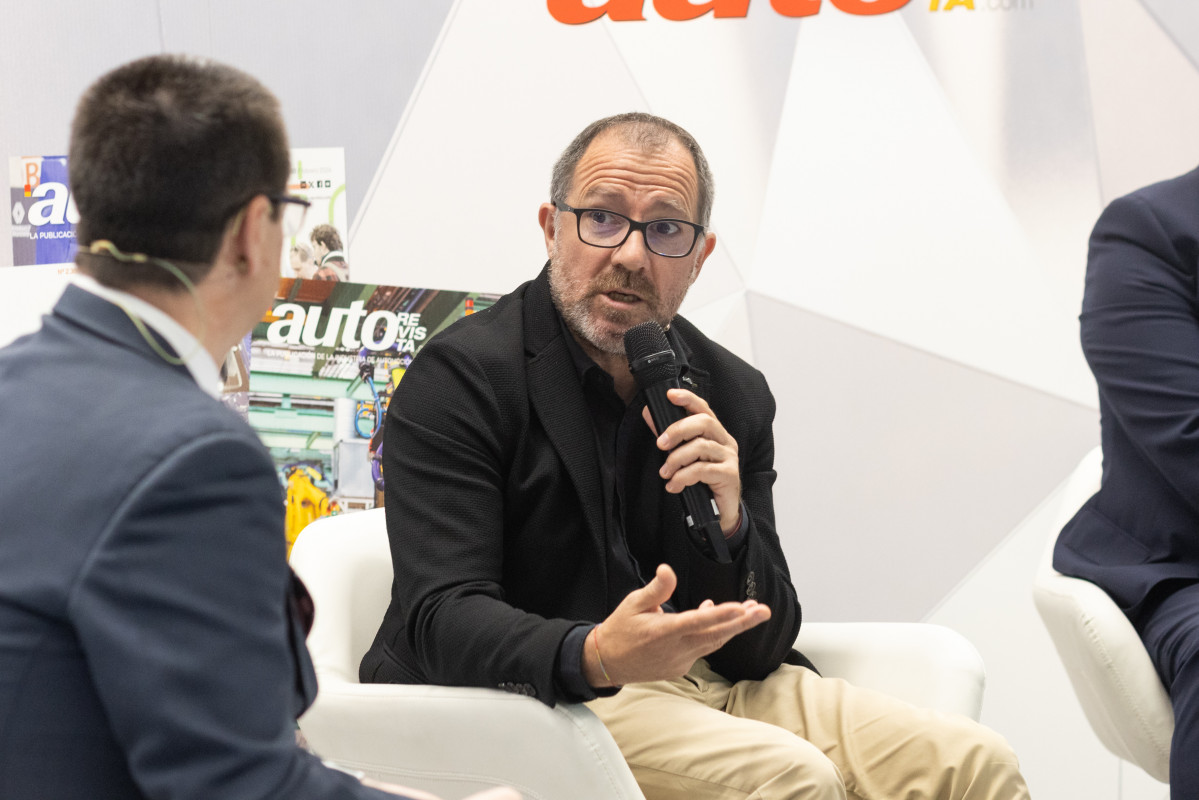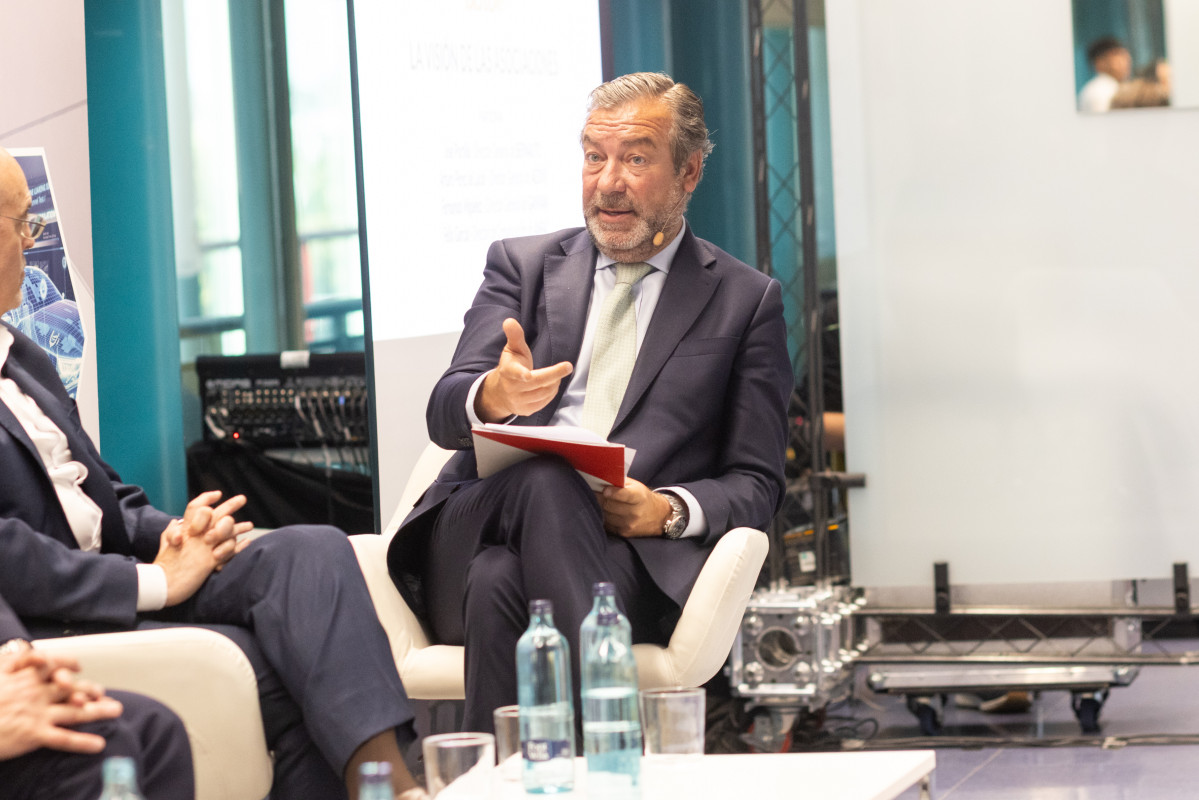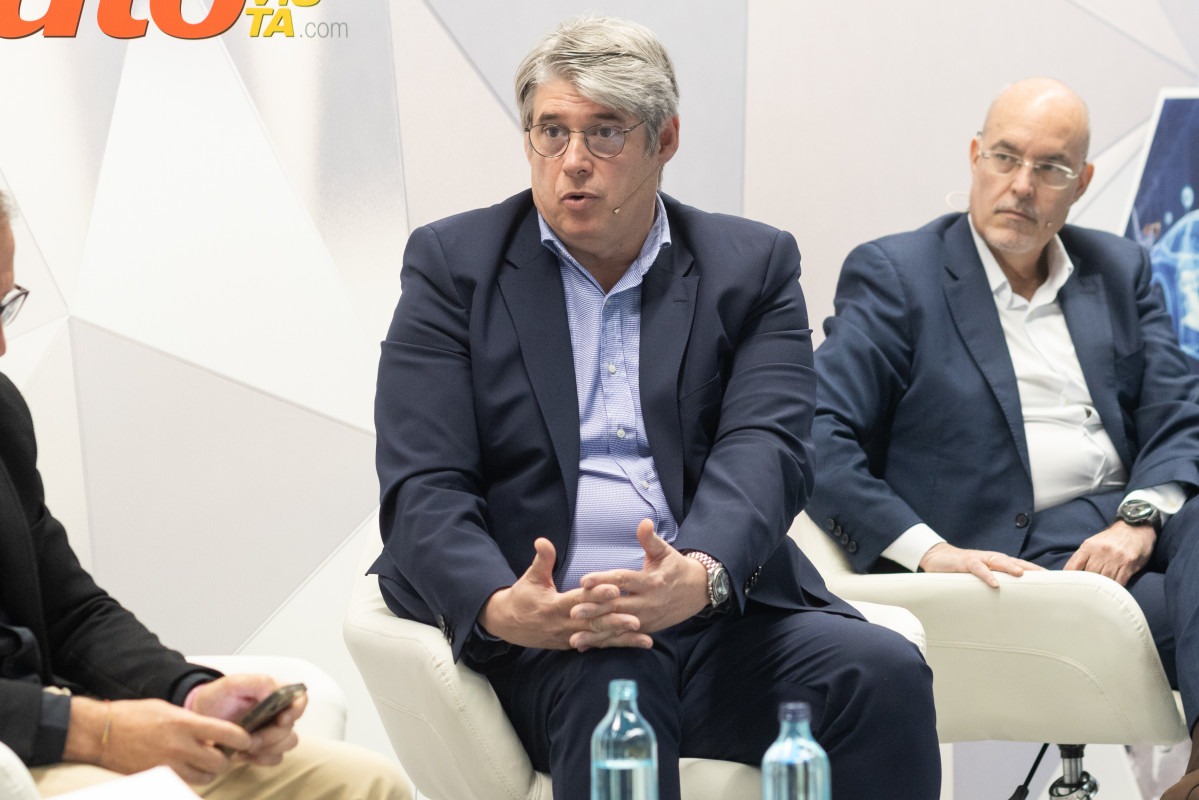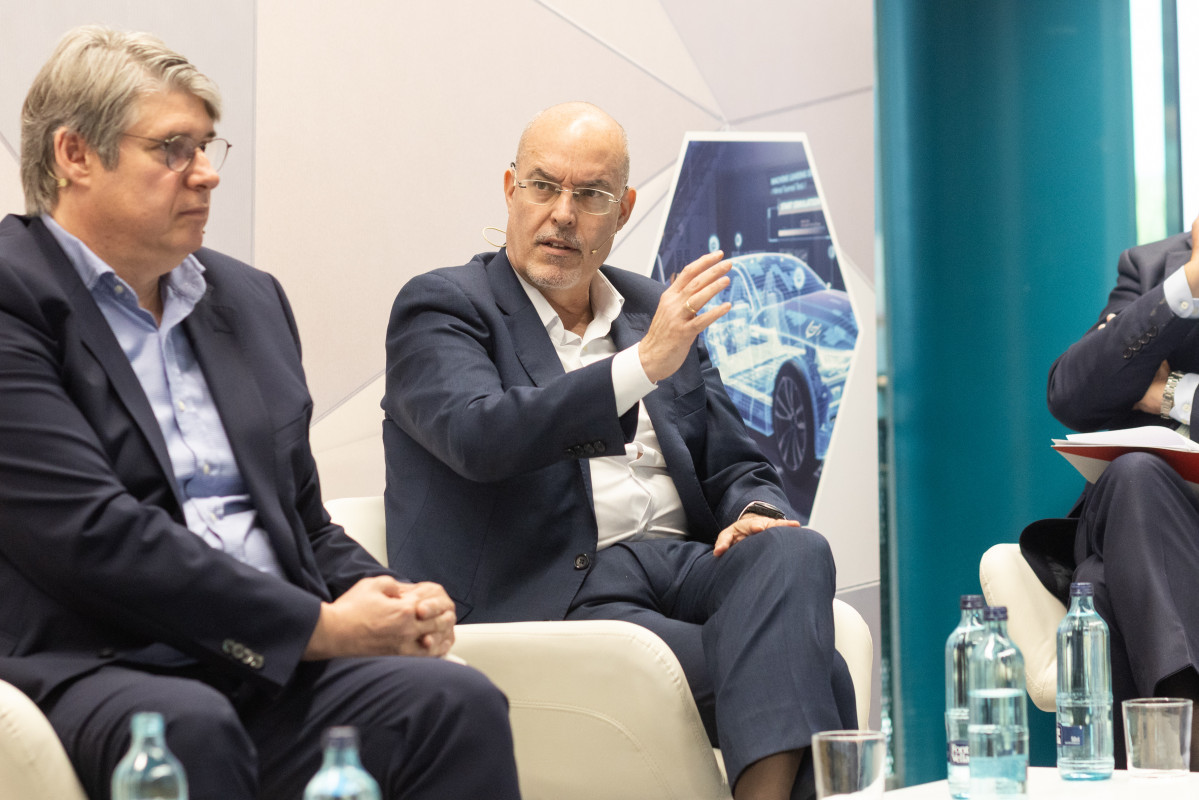The vision of the associations

The first round table of AutoRevista's 65th anniversary event was made up of participants from four associations, not the only ones, but fundamental to understanding the sector in recent decades, spanning more than half a century between them.
In the first part of the event we had representatives from GANVAM, founded in 1957; SERNAUTO, born in 1967; ANFAC, formed in 1977; and AEDIVE, created in 2010. In order to highlight the roots of these key entities in the historical development of the sector and which in recent years have fostered synergies to defend common interests in various fields, the colloquium featured the expert voices of Fernando Miguélez, CEO of GANVAM, José Portilla, CEO of SERNAUTO, Félix García, Director of Communication at ANFAC, and Arturo Pérez de Lucía, CEO of AEDIVE.
Félix García (ANFAC) stated that "in 1977, ANFAC was made up of only 13 brands. It is true that there were not so many brands in the Spanish market at that time. In that year, 1.1 million units were produced with less manufacturing development and before the pandemic, around 2.9 million units were produced in a year. ANFAC currently has 59 brands. Previously, the brands were related to the manufacturers in Spain, but we have been incorporating importers with very relevant market shares, including commercial vehicles and buses. Having 95% of the representation and collaborating with the other associations in the sector gives us great strength to defend the sector, in what we understand as excessive regulation in recent years, to which we are adapting and which is imposed by the legislation to sell zero-emission cars and vans from 2035. The electric vehicle is advancing at a slower pace than we would like, but in Spanish factories, in 2023, more than 320,000 electrified vehicles were manufactured compared to 16,000 before the pandemic. Therefore, we are doing our homework, but now we need the market to want to buy this type of vehicle. The association has evolved along with the sector and society, hence the preparation of studies, reports and analyses updating every aspect of the sector, in some cases in collaboration with other associations, to promote and disseminate the weight of the industry in areas such as Industry 4.0 or in areas such as Neutral in Motion".

Fernando Miguelez (GANVAM) recalled that "in 1957, Spain was experiencing economic difficulties and the Ministry of Finance of the time had to build a system of accreditation of economic activities, which is reflected in the CNAE code, number 45 of which is the sale and repair of motor vehicles. 500 businessmen met in 1957 to create GANVAM to determine their tax contribution to the State in a market of 25,000 passenger cars and 150,000 motorbikes, which grew 15 years later, in 1972, to half a million passenger cars. As for 2024, I am optimistic that we will exceed one million sales of new cars and two million used cars. It is an ecosystem that nurtures citizens so that they can choose their mobility option. We are accompanying the industry in all the disruptions (new forms of mobility, digitalisation, electric vehicles, autonomous vehicles) that we are facing. We are all necessary actors in the construction of new mobility solutions. At GANVAM we take on the challenges of zero emissions, zero accidents, zero non-connected vehicles and of providing solutions to citizens in an ecosystem in which there are dealers, independent distributors, workshops and official services to accompany these challenges".
Arturo Pérez de Lucía (AEDIVE) commented that the idea of creating the association was forged in 2009, when the drive for electric mobility began and with the aim of electrifying mobility and electric mobility transport. At that time, the Government's MOVELE Plan and the need to develop regulations based on the ITC BT 52 and the complementary technical instruction for the deployment of charging infrastructures arose, creating a whole ecosystem. Our objective, as early adopters and absolute believers in this technology, is to work with the Public Administrations, but also to work with the ecosystem to generate successful business models, necessary for electrification to take place. We were born at a time when people did not talk about electric mobility or electric vehicles because they did not believe in it. I use Gandhi's philosophy that first they ignore you, then they mock you, then they attack you, and in the end, you win. We are in the phase between "they attack you and you win". When we were born, the government responded so that we would be welcomed in the value chain and we collaborate with entities such as Neutral in Motion. I am vice-president of the European counterpart association and we see, in the case of Spain, that our main export destinations are countries that in 2035 will stop marketing combustion vehicles. The transformation cannot be carried out by the sector alone, but requires the collaboration of administrations that not only set objectives, but also establish the mechanisms to achieve them".
José Portilla (SERNAUTO) began his speech with the anecdote of the origin of the name SERNAUTO "in the only reference I found in the Google oracle, in a doctoral thesis by an industrial engineer in 1969, which mentioned the constitution, in Zaragoza, of a company made up of five companies which, at that time, were suppliers of Fiat. In line with other associations linked to the vertical trade unions of the Franco era, it was set up as the National Automotive Service (SERNAUTO). Our evolution is related to the exponential growth of the sector with the creation and professionalisation of departments and services. We currently have around 360 associates, representing 85% of the turnover of a sector that has more than 1,000 companies. A fundamental key to SERNAUTO's success is the involvement of its members in the day-to-day running of the association through the different committees we have set up. They do so in a very committed way, generating valuable information for the members' decision making. On the other hand, I would like to emphasise that collaboration between the sector's associations has accelerated exponentially since the pandemic and the unity of our voice is recognised by the public administration. The industry, the commercial side and the electrification side are all united in pushing for the levers and tools that this sector urgently needs to be able to move successfully at the moment, encouraging the government in a slightly more accelerated way, although we are grateful for initiatives such as the PERTEs.

Current challenges
When addressing the current situation, Félix García (ANFAC) explained that "2035 is here, there is no turning back, there is no Plan B. We have to sell zero-emission vehicles and, in the short and medium term, the only technology that allows us to achieve this objective is the electric vehicle. We must move towards lighter vehicles, powered by renewable energy sources. It is a challenge and an opportunity, but we have to keep pace with the times of industry. Our associates are already developing the vehicles that will be launched in 2033, 2034, 2035... In Europe, the major manufacturers are investing 250,000 million euros to change the entire production process; public-private collaboration is essential, with society as a whole, so that this effort is in demand. What is the point of having cars on the market if people do not buy them? Why are companies not given tax incentives to buy electric vans? From the associations, we demand a greater effort to publicise electric vehicles and that the dissemination does not only come from our side. Of course, we must continue to increase the charging infrastructure on the premise that the electric vehicle must be sustainable and profitable for the company from the very first minute".
Fernando Miguélez (GANVAM) pointed out that "the backbone of the offer and services to citizens is distribution, dealers, independent services, official services, agents and workshops. It is impossible to understand how this offer can reach customers without resolving the challenges we face. With regard to collaboration, during the pandemic, the sector's associations, ANFAC, SERNAUTO, FACONAUTO and GANVAM went to Moncloa to sign the only Value Chain Promotion Plan that ever existed in Spain. That plan already talked about recharging points, aid for innovation, business development, new taxation to promote electrification, but there were also many actions that have not been carried out. We are facing a very old fleet with an average age of 14.2 years, which means that there are millions of vehicles more than 20 years old. The mobility of the present and the future has many surnames, safe, connected, but it must be accessible. 83% of citizens would be willing to renew their vehicle, but have neither the facilities nor the tools to do so. . Proposals such as Macron's social leasing in France have proven to be good tools. The possibility of accessing an electric vehicle for 100 euros was a success and the supply of 25,000 units was too small to meet the demand for twice as many. It would be interesting to introduce 50,000 electric cars in the Spanish market in one go and make progress with respect to the current 5 or 6% penetration rate. The reindustrialisation of Spain is very important and we support it, but there are also those thousands of SMEs, represented by GANVAM, which are the backbone of the whole supply chain and need a boost to face the same challenges as the large ones that were initially excluded from the PERTE. We need to structure the entire value chain towards accessible mobility".

Arturo Pérez de Lucía (AEDIVE) commented that "when electrification began, we missed a communication plan from the government and there has never been one. There have also been mistakes in the private sector regarding the charging infrastructure and there has been a certain fear among the population that if you buy an electric vehicle, you will not be able to drive it. A lot of information has also been disseminated through social networks in search of notoriety, which does not match the reality". Pérez de Lucía commented that "the reality is that the charging infrastructure has an average usage rate of 6%, and there is sufficient deployment to travel around Spain and Europe. We need vehicles with high battery capacity and high power charging capacity to have the same user experience as a combustion engine user. There are also vehicles that charge at lower power and have a shorter range. There have been, therefore, a series of messages that are now difficult to reverse in order to get the public excited about electric mobility.We have a government that through its ministries of Ecological Transition and Demographic Challenge, Transport and Industry supports electric vehicles, but where is the Treasury? When the Government is not aligned in a PNIEC in which they raised from five to 5.5 million, which means registering 700,000 a year when in 2023 140,000 were registered. There is still a lot to be done and the government needs to take strong measures to help manufacturers, component suppliers and sellers to promote electric vehicles, with an impact on prices".
José Portilla (SERNAUTO) stated that "the components sector is currently facing a real challenge. Fortunately, it has always been very resilient, very flexible... Otherwise, it would not be possible for us to have 450 factories around the world. We are moving in a scenario of uncertainty with geopolitical and logistical tensions, regulatory pressure that we have never seen before, changes in user habits... To advance in this transition, we have to invest, both in processes and products as well as in R&D&I. We have to remember that all the decision-making centres of the industrially based vehicle manufacturers in Spain are abroad, and when these manufacturers assign models, they do not only assess the competitiveness of the factories or how distribution works. They look, in a very special way, at the supplier park surrounding their factories. Therefore, in order to make it easier to allocate vehicles to Spain, we have to promote technological differentiation at a competitive price. Suppliers are at ratios of 3.5% of the sector's total turnover, which is more than three times the average for Spanish investment. This is a lever that we must continue to activate and which requires a lot of effort. At this point, I am not so worried about Spanish and foreign multinationals in Spain, although they are obviously going to make complex decisions, but I am worried about SMEs because they have to continue investing in R&D&I, undertake productive investments, while they are paying the ICOs of the pandemic. We have many companies with financial and cash flow problems. Many are going to fall by the wayside. We are saying that we have to be more agile with an effective fiscal policy for both industry and distribution, with incentives and aid for demand, but also for supply. for industry. There are companies that are locating technology centres in France because of the greater tax benefits. Within the Alliance for the competitiveness of industry, we have drawn up a very ambitious new industry law that requires resources and the coordinated participation of the Administration. But we need to run faster because we are lagging behind”.
Ten-year evolution
As for the forecast to 2035, Félix García (ANFAC) pointed out that "we would like to continue to be the second largest European car producer when only zero-emission vehicles are manufactured, representing 10% of GDP along the entire value chain. However, as an example, it has taken more than three years to fill the gap left by Nissan's departure from the Zona Franca in Barcelona with projects. When a factory leaves, it is difficult for it to return, and the new Industry Act should make it possible to eliminate obstacles and improve aspects that make us less competitive than our neighbouring countries. Another problem is the high rate of absenteeism. To reduce it, we have to work together with the trade unions. We have to cooperate to maintain competitiveness, to take advantage of our capacities as a country in renewable energies, of which, in some regions, we even have a surplus".
Fernando Miguélez (GANVAM) pointed out that "we need a strong industry that drives the entire value chain when it comes to facing the challenges we face. We must bear in mind that sales of new vehicles will not exceed pre-pandemic levels until the end of this decade. At the current rate, the percentage of electric vehicles will be 30% in 2030 and, in that year, two out of three cars will be services. In this challenging context, it is clear to us in the distribution sector that our businesses must be profitable with quality employment, for which we need qualified employees. The Administration has to favour the professional profiles we need. We still have no response to these key issues, so we must work together to put the needs of the sector on the political agenda".
Arturo Pérez de Lucía (AEDIVE) commented that "the value chain has expanded with new players such as top-level charging infrastructure manufacturers, gigafactories, recycling plants and energy storage systems with second-life batteries. On the other hand, in Spain we are absolutely dependent on the purchase of fossil fuels from third countries, but we are capable of generating our own energy to power buildings, industry and mobility. Compared to other global regions, we have to be self-sufficient and resilient, generating our own capacities. Hopefully electrification will become widespread as soon as possible, but we need to renew the fleet, achieving the objectives in a coherent way.

José Portilla (SERNAUTO) explained that "in recent months the situation of supplier margins has worsened, so I appeal to vehicle manufacturers to take a long-term view and develop partnerships to strengthen the supply chain. In line with this, try to anchor and capture certain critical components that provide strategic autonomy. On the demand side, we call for a Plan Renove that also includes the purchase of 'clean' combustion vehicles, Euro 6d and Euro7. As I said before, a long-term Industry Law, which does not change substantially with each new government".
After the last round, David Romeral, managing director of the Aragonese automotive and mobility cluster (CAAR), recalled the presence at the event of representatives of five of the ten existing clusters in the sector in Spain, which, in their organisations bring together suppliers and OEMs, expressed their concern "about overcapacity related to the lower number of manufacturing hours and whether this could lead to the insourcing of certain components by OEMs". Félix García (ANFAC) commented that vehicle manufacturers "are working on the Mobility as a Service trend. We may need fewer engineers on the lines, but we will need more software engineers. In terms of components, we will continue to rely on suppliers for a question of economies of scale”. José Portilla (SERNAUTO) agreed that "there are some movements towards insourcing, but also new outsourcing projects. The OEM platform policy is transferring the assembly of certain assemblies to Tier 1 and even Tier 2. There will be a high level of customisation of high-end vehicles, but also standardisation for electrified vehicles. Regarding employment, of the 220,000 jobs in the supplier sector, 70,000 are related to the combustion engine. A recent report by CLEPA, with the relevant participation of SERNAUTO, indicates that in 2032, some 40,000 of the 70,000 jobs mentioned above would be lost, but some 25,000 would be generated by software engineers and electrification. Undoubtedly, there will be a penalty to employment, but we must promote the upskilling and reskilling of workers".

Lea este artículo en castellano

AutoRevista participó en la reciente prueba dinámica del nuevo Renault Symbioz, SUV del segmento C que se ubica entre los modelos Captur y Austral. Texto y fotos: Luis Miguel González

Sandvik Coromant ha reunido en su sede de San Fernando de Henares (Madrid) a cuatro voces autorizadas del mundo de la industria del mecanizado en una mesa de debate, de la que AutoRevista fue testigo, donde han dado su opinión sobre el futuro y los retos que aguardan a este sector.

La Asociación Nacional de Fabricantes de Automóviles y Camiones, ANFAC, ha presentado, en la mañana del 10 de julio, su Informe Anual.

Profesionales del primer nivel de las empresas de la industria de automoción y movilidad se han congregado en una jornada organizada por CEAGA en Vigo para ofrecer a los líderes del sector una visión práctica y multidisciplinar que les permita anticiparse y responder eficazmente a los desafíos del entorno.

SERNAUTO ha publicado su memoria de Sostenibilidad 2024, en formato Informe Integrado, que constituye un análisis exhaustivo de la actividad, aportación de valor y papel activo de la entidad como portavoz del sector.
